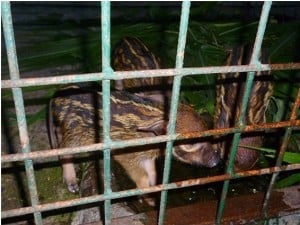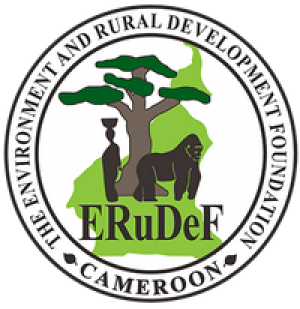[one_third] [/one_third]
[/one_third]
The Environment and Rural Development Foundation (ERuDeF) in collaboration with the Divisional Delegation of Forestry and Wildlife have rescued 3 piglets of Red River Hog (Bush pig) Potamochoerus porcus from Wildlife Traffickers. The piglets were seized on June 11, 2014, from Nkemngoh Michael a resident of Menji, headquarter of Lebialem Division, SW Cameroon. The operation was led by the Divisional Delegate of Forestry and Wildlife, Mboui Jacques in collaboration with the forces of Law and Order and ERuDeF’s Enokenwa Allen Tabi. The piglets have been taken to the Limbe Wildlife Center for rehabilitation.
The trafficker, Nkemngoh is said to have bought the piglets from hunters who caught the piglets in the proposed Mak-Betchou Chimpanzee Sanctuary and his aim was to sell these piglets to ERuDeF for about 70.000 FCFA($140) or more. When staff of ERuDeF asked him to hand the animals for free, explaining the consequences of keeping or selling an animal that is protected by the laws of the country, he refused. His refusal pushed ERuDeF staff to inform the Divisional Delegate and the Forces of Law and Order who later arrested him.
A week before this incident, 2 baby civets were brought to the ERuDeF field office at Menji by a man from Atongue village who claimed he found the animals around his house. These animals were taken to the Limbe Wildlife Center by ERuDeF in collaboration with the Divisional Delegation of Forestry and Wildlife for Lebialem.
It would be recalled that the Red River Hog species falls under the class B animals which are totally protected by the Cameroon Forestry, Wildlife and Fishery Law N° 94/01 of 20 January 1994. The law states that this animal should not be killed and their capture or detention requires a special authorization from the Ministry of Forestry and Wildlife.
The red river hog (Potamochoerus porcus), also known as the bush pig is a wild member of the pig family living in Africa. It is rarely seen away from rainforests, and generally prefers areas near rivers or swamps. Red river hogs eat grasses, berries, roots, insects, molluscs, small vertebrates and carrion. They typically live in herds of six to 20 members led by a dominant boar, with sows rearing three to six piglets at a time.
Enokenwa Allen Tabi
